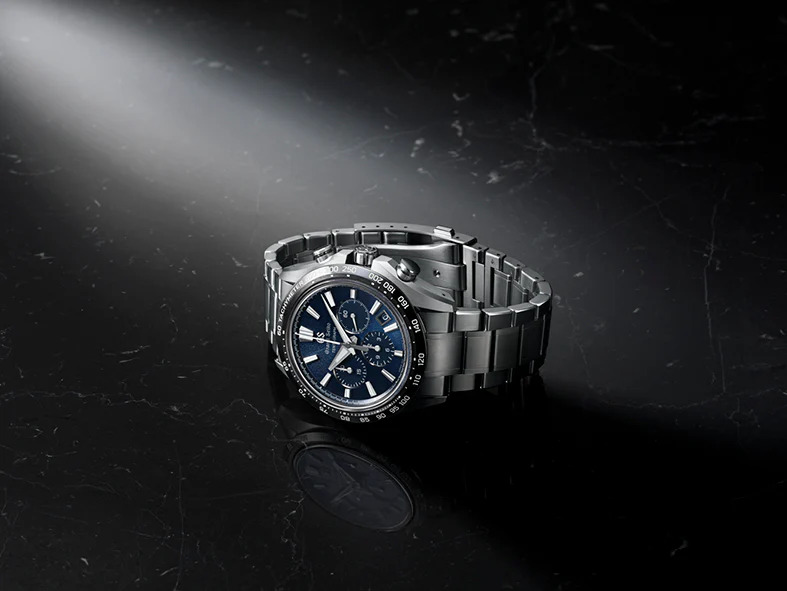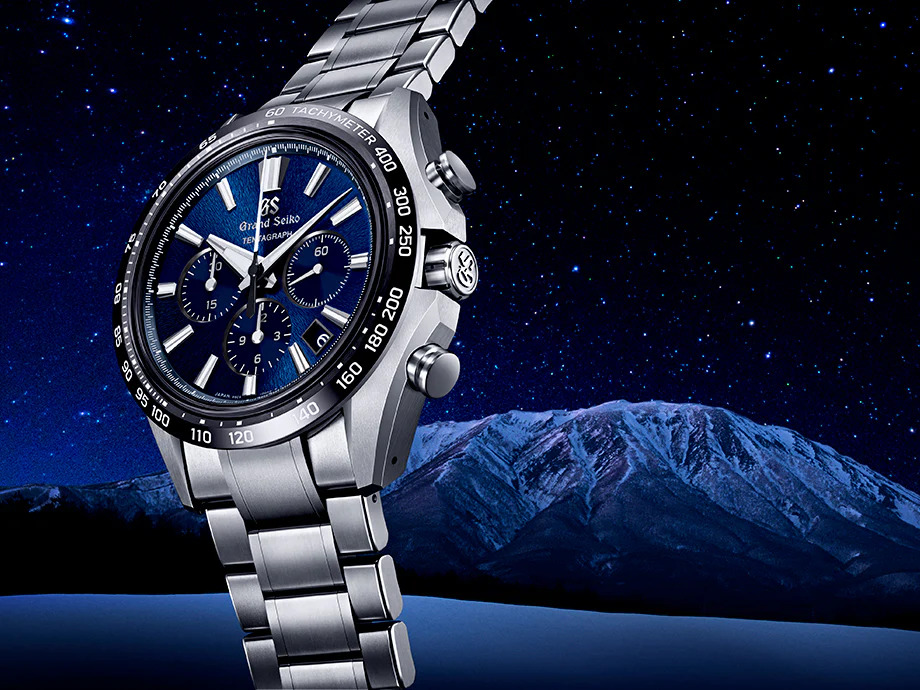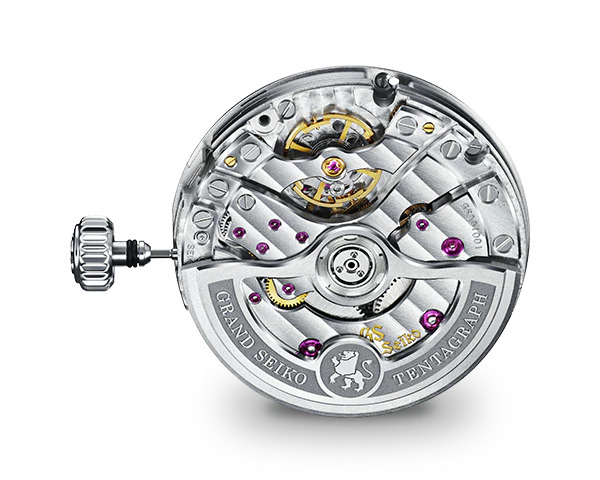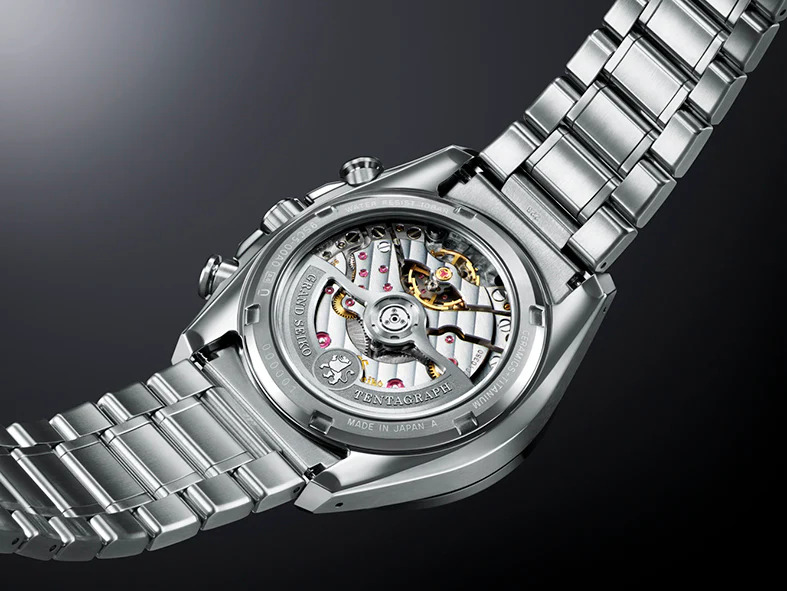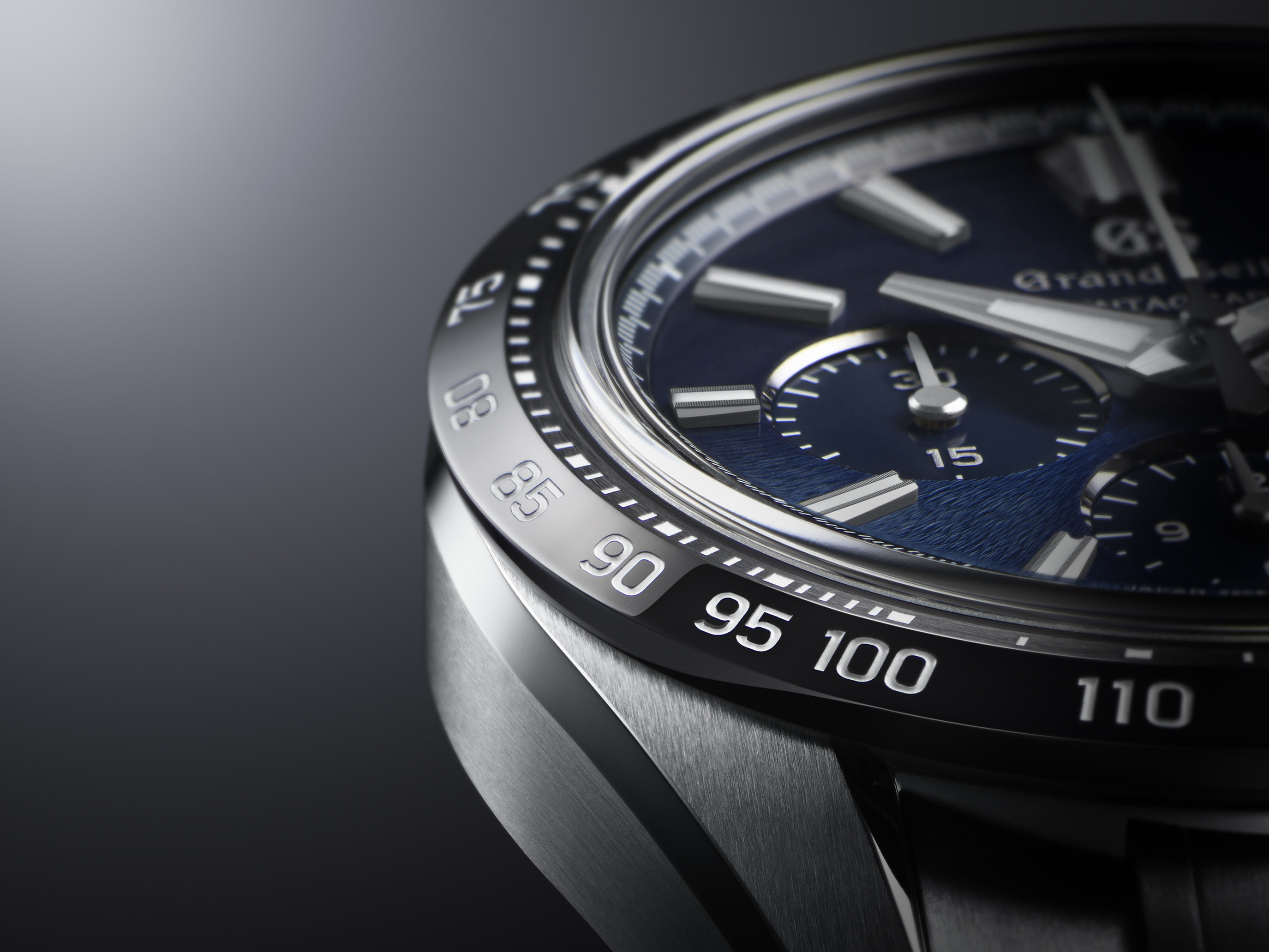Holding a magnificent piece of Japanese craftsmanship in my hand, the Tentagraph, I see its intricate details, and experience up close Grand Seiko’s penchant for being exacting. From the dial all the way through to the case, bezel, bracelet, and clasp, the watch draws one in with its deep-hued, carved face, even as the case glints and shines with Zaratsu polishing and hairline finishing. On turning the watch over, there’s the brand’s first high-beat mechanical chronograph movement, the Caliber 9SC5. The frequency at which this automatic movement beats is 36,000 vibrations per hour or 10 beats per second, giving it a mean daily rate of +5 to -3 seconds; its power reserve is 72 hours. All of this comes housed inside a 43.2mm scratch-resistant, high-intensity titanium case.
The Grand Seiko Product Planning Department says they were aware that Grand Seiko patrons had long awaited a mechanical chronograph from the brand. And it was in Watches and Wonders 2023 in Geneva that this demand saw fruition. “As the watch that would become the first mechanical chronograph movement in the brand’s history, the Tentagraph was developed to represent the ideals of the Grand Seiko Sports watches,” the brand’s Product Planning Department explained.
The Mechanics
And the watch achieves this, from the looks of it, quite effortlessly, even though the Tentagraph was two years in the making. We’ll begin with the mechanics because that really is the pièce de résistance of the watch. For the Tentagraph, Grand Seiko’s watchmakers have taken the mechanics of the high-beat movement and melded it with the design of the Evolution 9 style.
The name Tentagraph is a portmanteau of ‘Ten’ beats per second, ‘T’hree days, ‘A’utomatic, and Chrono‘Graph’. A high-beat rate, a long power reserve, and automatic chronograph function are what essentially personify this timepiece. The high beat rate accounts for the precise time reading in the chronograph and the time of the day, and the energy-efficient escapement and two barrels allow the watch to work for three days, even when the chronograph function is running. “A high frequency and long power reserve are inversely related, but Tentagraph achieves both,” says the Grand Seiko Product Planning Department. “Based on our research, it is the 10-beat chronograph with the longest power reserve in the industry today”, they added.
The new Caliber 9SC5 boasts Dual Impulse Escapement, a mechanism that efficiently transfers energy to the free-sprung balance wheel indirectly through the pallet fork, as well as directly from the escape wheel. Another important factor is that Micro-Electro-Mechanical Systems, or MEMS, a fabrication technology utilised by Grand Seiko for its mechanical movements to create high-precision and durable microstructures, has been used to manufacture the parts of the movement. This makes the escapement highly durable and energy efficient to achieve a long power reserve. Overall, the movement became precise and lightweight. Its details are visible through the sapphire caseback, where one can see the oscillating weight that bears the engraving of the brand’s symbol, a lion, with the letters ‘GRAND SEIKO TENTAGRAPH’.
To be within the Grand Seiko standards of +5 to -3 seconds per day, the Tentagraph was put through a testing process of 20 days, where for the first 17 days the time-of-the-day accuracy was analysed in six different positions at three temperatures. For the next three days, the accuracy of the watch was tested in three different positions when the chronograph movement
was running.
Creating such a movement would not be easy. “In 2009, Grand Seiko introduced Caliber 9S85, which was the first 10-beat movement in almost 40 years. Since then, there have been constant requests for a high-beat Grand Seiko mechanical chronograph, but in creating it we wanted to achieve a standard of precision required of Grand Seiko, and at the same time, the ability to last three days,” the Grand Seiko Public Relations Office informs us about the movement’s development. “In 2020, Caliber 9SA5 was successfully produced, and the performance of a 10-beat movement with 80-hours power reserve was achieved. The conditions for producing a Grand Seiko high-beat chronograph were now set.”
The Design
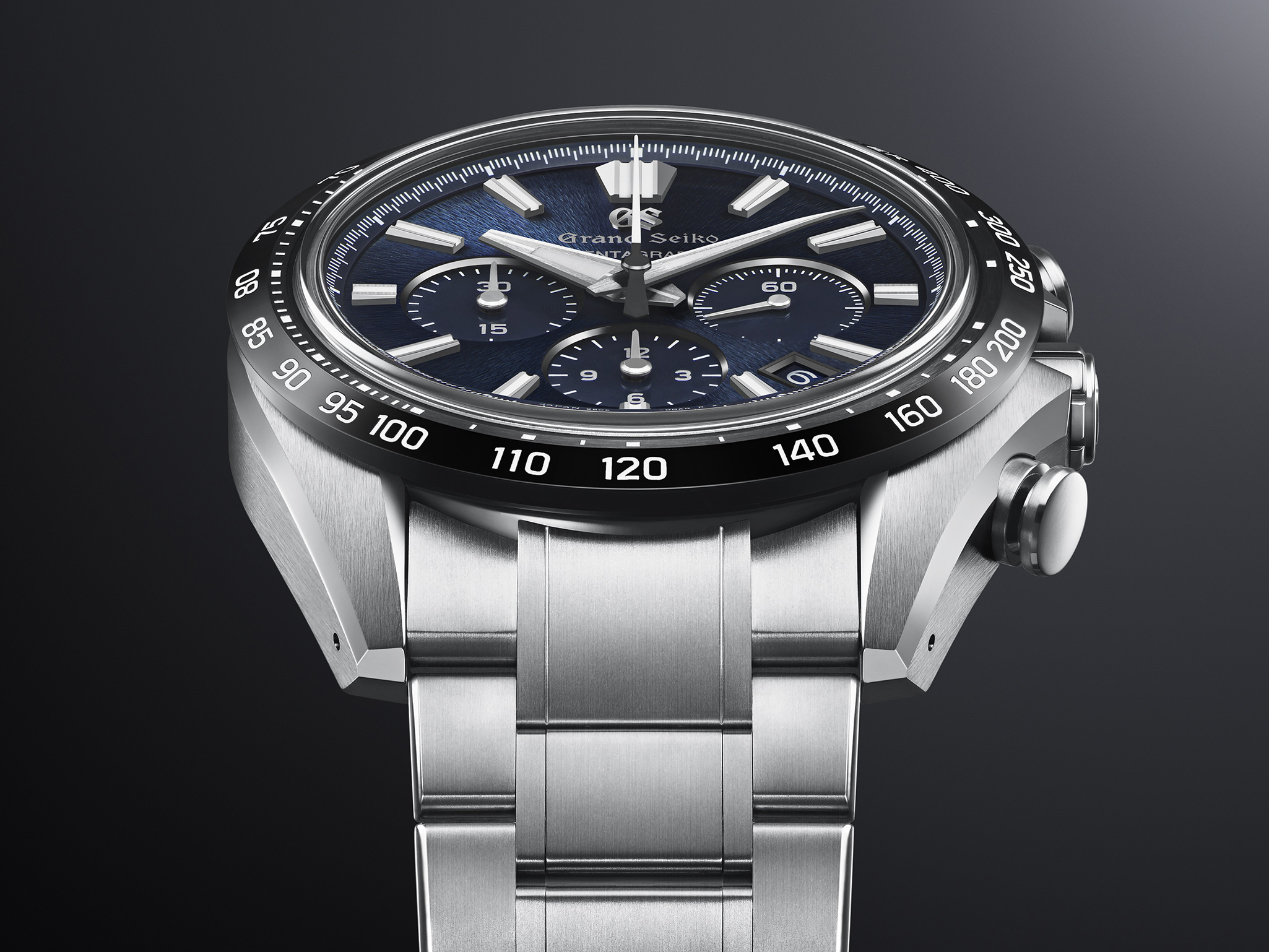 Grand Seiko Tentagraph
Grand Seiko TentagraphIt was in 2020 that Grand Seiko unveiled the Evolution 9 design philosophy of the brand where form and function were cast in perfect harmony. Focusing on legibility, ergonomics, and aesthetics, watches sporting the Evolution 9 style present a more nuanced approach to design, and this is evident in the Tentagraph as well.
Starting with the dial, the Tentagraph features the brand’s signature ‘Mt. Iwate pattern’, reminiscent of the ridged contours of the Mt. Iwate mountain, which is visible from the windows of the Grand Seiko studio based in Shizukuishi. The deep blue takes inspiration from the mountain peak at night, but even with this, Grand Seiko has ensured that the dial remains highly legible. At 3 o’clock lies the small seconds counter, the 12-hour counter is at 6 o’clock, and the minutes counter at 9 o’clock-all blue and with white markings, the three sit slightly recessed into the dial. The hour markers are grooved and the hands are broad and strongly designed, all coated with LumiBrite, Seiko’s proprietary luminous paint that is brighter and longer-lasting, with a green luminescence.
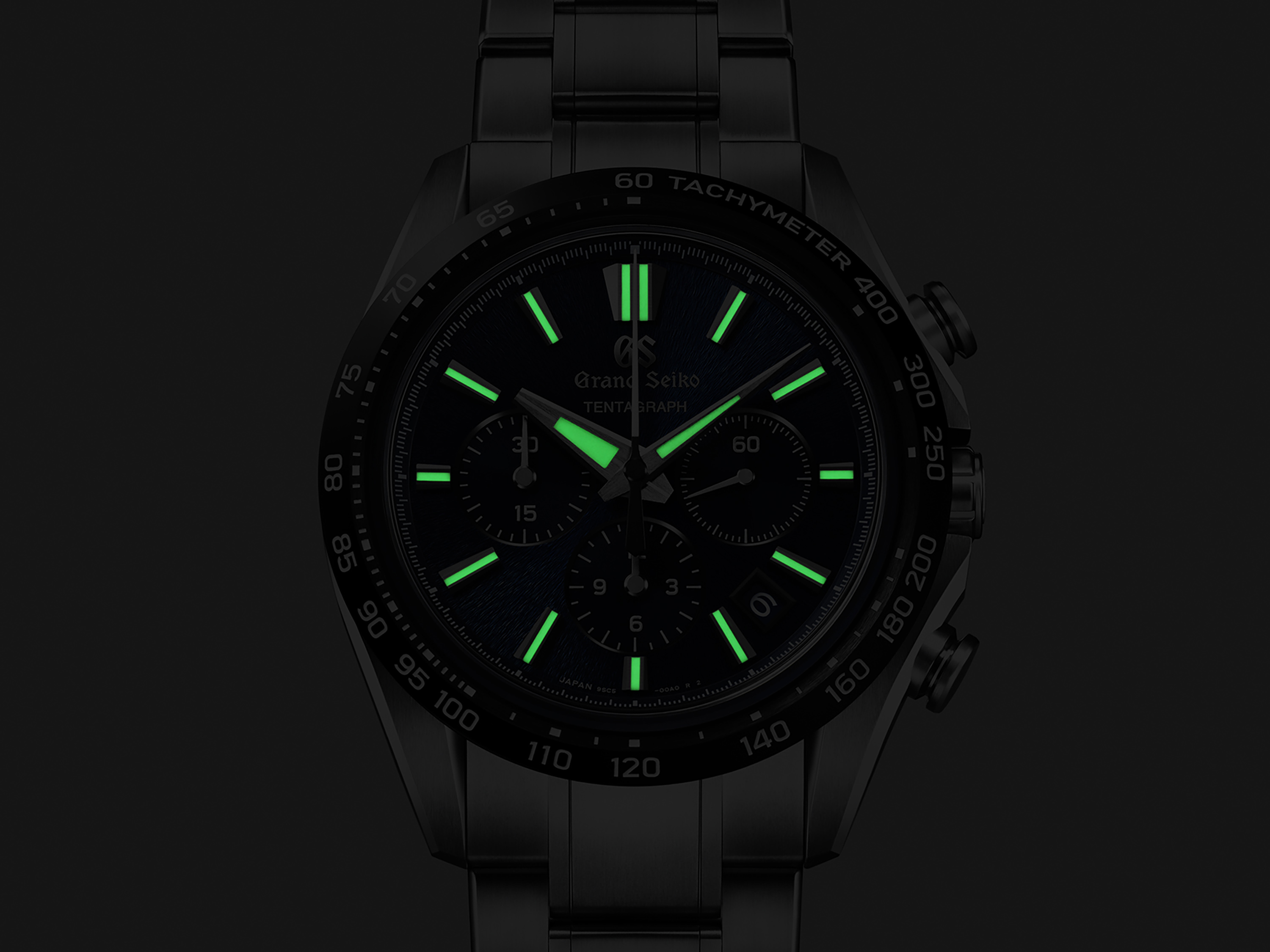 Seiko’s proprietary LumiBrite on the hands and indexes glows green
Seiko’s proprietary LumiBrite on the hands and indexes glows green“For the first time in a Grand Seiko mechanical watch, we utilized a two-layered dial. A chronograph has a lot of information on the dial, so by incorporating two-layers, the readability of each individual function increases. A two-layered dial allows the distance between each hand and the index to be closer, but we also wanted to make good use of the dial colour and the height difference to show the beautiful contrast of light and shadow across the dimensional dial,” the Product Planning Department explained.
 The two layered blue dial inspired by Mt. Iwate
The two layered blue dial inspired by Mt. IwateThe central chronograph hand is gently curved down such that its tip extends to the edge of the dial and comes as close as possible to the hour markers. The central minute hand is also curved down to ensure legibility while the hour hand is significantly truncated, which gives it a significant presence on the dial. The date window at 4:30 matches the colour of the dial as well. Furthermore, the dial is topped by a box-shaped sapphire crystal (with an anti-reflective coating), which helps reduce the gap between the hands and the dial to improve legibility and reduce the
thickness of the bezel and the overall watch’s appearance.
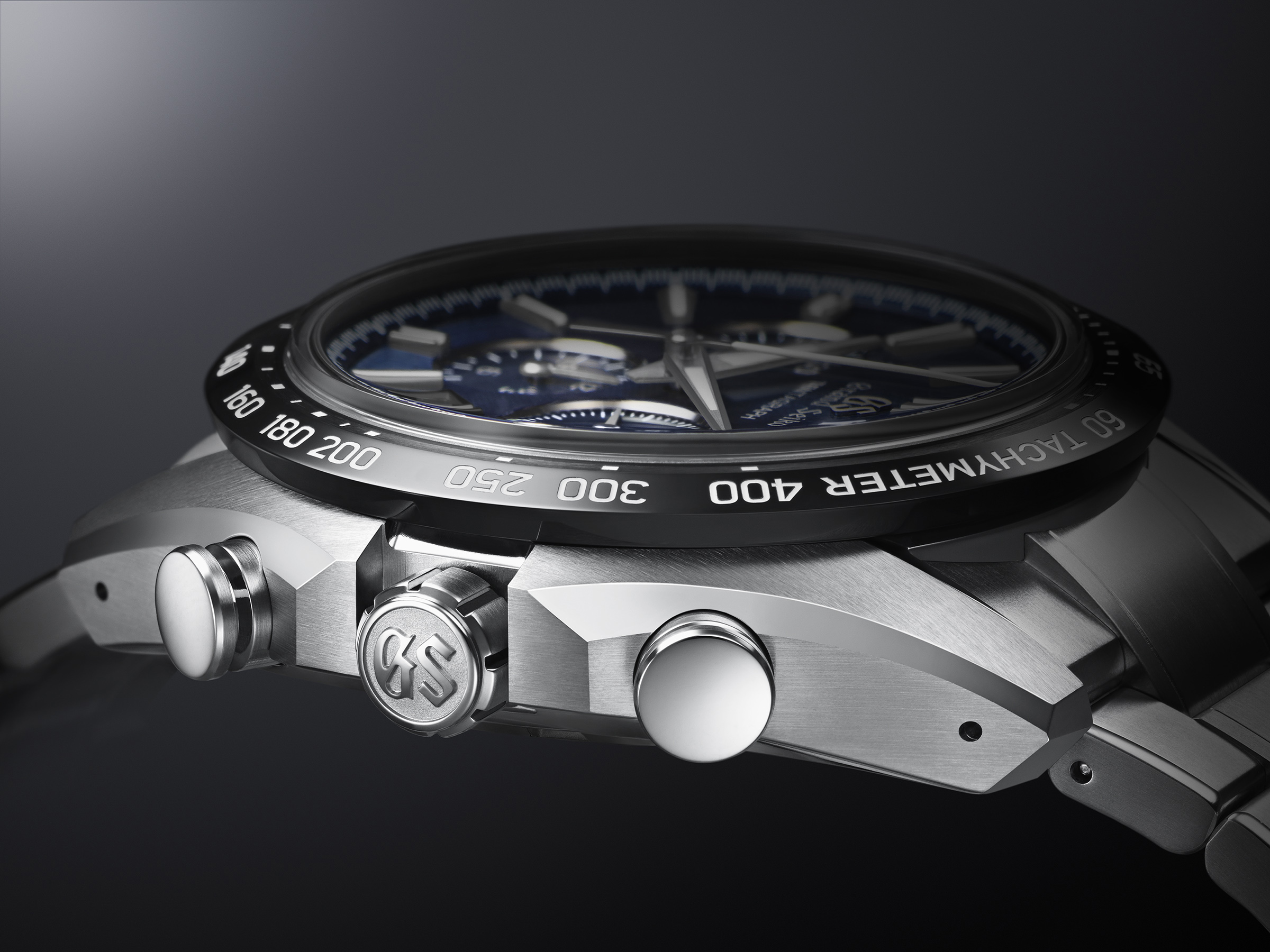 The Zaratsu and hairline finished high-intensity titanium case with ceramic bezel
The Zaratsu and hairline finished high-intensity titanium case with ceramic bezelIn keeping with principles of ergonomics of the Evolution 9 style, the Tentagraph’s high intensity titanium case is truly lightweight and the watch’s curved profile, wide lugs, and low centre of gravity ensure that it sits comfortably on the wrist. The watch has also been designed in a way that the screw-down crown featuring the Grand Seiko logo and pushers are on the same level to create a solid, stable feel and appearance. The convex pushers allow easy operation to measure and read the elapsed time on the chronograph. To add to this, the bezel with ceramic insert protects the watch from scratches and improves durability, and features an engraved tachymeter scale.
Details are key to Grand Seiko, and proving this are Zaratsu, which is a distortion-free flat mirror finish, a signature of the brand, and a hairline finish, wherein extremely fine lines of the same depth are achieved on a surface with the help of sandpaper. These grace the case and the three-link titanium bracelet alternately to create a winning play of light. The bracelet has a push button release, and the watch is water resistant up to 100 metres.
History
The story of Grand Seiko’s high-beat mechanical movements started in 1967 when the brand introduced its first automatic movement, the 62GS, a breakthrough for the Japanese brand that led to a new story in its technological advancement. The automatic 10-beat 61GS movement and manual 10-beat 45GS carried forward the technology in 1968-that same year, Grand Seiko won the Geneva Observatory competition for its mechanical movements. Adding more feathers to its newly donned cap, the brand also succeeded in winning important chronometer competitions in Japan. The next in line was Grand Seiko’s first timepiece for women equipped with a 10-beat movement, the 19GS; followed by high precision 61GS and 45GS V.F.A. (Very Fine Adjusted) models in 1969, and 56GS and 61GS Special models in 1970. The world saw a rapid development in the Japanese brand’s ‘calibre’ in mechanical movements.
 Craftsmen working in the Grand Seiko studio
Craftsmen working in the Grand Seiko studioWhile the Spring Drive movements, which offered a one-second-a-day accuracy, came in 1999, improving the high-beat movement never took a backseat at the brand. Caliber 9S67 made a debut in 2006 with 72 hours of power reserve. The development of the 9S movement continued with the evolution of the high-beat movement where a new alloy was made for the mainspring of the calibre that offered more resilience to shock and a power reserve of 55 hours. Later, Caliber 9S86 was created, a mechanical Hi-Beat 36000, which had a GMT function. Thereafter, a series of new high-beat mechanical calibres were created with new alloys and techniques from 2009 to 2014. The year 2016 had the first all-ceramic case housed with a Spring Drive - the Black Ceramic Limited Edition, and another, the Spring Drive 8 Day Power Reserve which ran straight for about 8 days. The 2020 Caliber 9SA5 was also released, becoming the finest mechanical movement of the brand, a new 10-beat movement that offered both precision and long power reserve. In 2021, the Grand Seiko Hi-Beat 36000 80 Hours won the 2021 Grand Prix d’Horlogerie de Genève (GPHG) in the Men’s Watch Prize category.
If you think about it, in a way the Tentagraph has been a few decades in the making, a culmination of all the high-beat movements that came before it. Not only has it bagged a GPHG nomination in the ‘Chronograph’ category this year, it is undeniably a milestone for the brand, the highest-precision mechanical chronograph ever created by the Grand Seiko.
The Studio
Set amidst the natural beauty of Japan, the Grand Seiko studio in Shizukuishi and its surroundings have served as an inspiration for the timepieces created here, and have a significant influence on the Tentagraph as well. The ridges of Mt. Iwate, visible from this studio, have been carved into the dial, and with the nightscape of the area lending its shade to the dial.
 Grand Seiko Studio Shizukuishi
Grand Seiko Studio ShizukuishiInaugurated in July 2020, the studio is dedicated to the creation of the brand’s mechanical watches. It is also the home to the craftsmen and women who work together to create the Grand Seiko timepieces. “Grand Seiko Studio Shizukuishi was built for two purposes. First, to communicate the understanding of Takumi, or Japanese craftsmanship, and the spirit that goes into each Grand Seiko watch to the wider audience by opening the studio to the public. The second was to provide the ideal environment for our craftsmen and women. It was our intention from the start to provide an environment that would expand the inspiration of those involved in Grand Seiko watchmaking,” explains the brand’s Public Relations office.
The studio has been designed by renowned Japanese architect Kengo Kuma, who also designed the Japan National Stadium. Designed with ‘Nature of Time’ philosophy, a workshop inside the studio provides the space where assembly and fine tuning of each timepiece is done. Another space displays the Grand Seiko history and crafts for the visitors, and a lounge that offers an immersive view of
Mt. Iwate.
The studio opened during the pandemic and although it was intended to welcome visitors, it could only be opened to the public last year. With more ideas brewing amidst the lush vistas of the
Grand Seiko studio, the maison plans to bring more creations that reflect its
brand philosophy.
